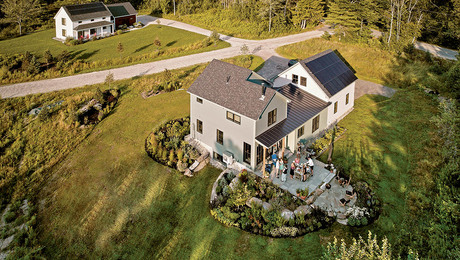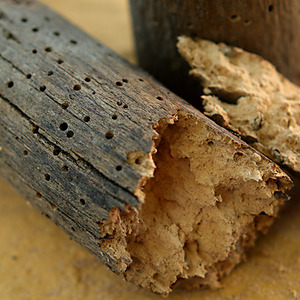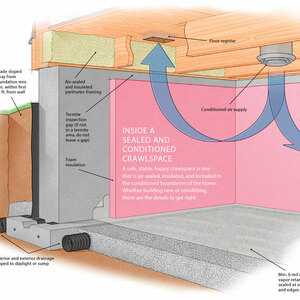Drywall Mudding Frustration
I admit I am a relative novice, but have now done my share of drywall taping and mudding. One thing I cannot seem to get around is I always end up with little ridges of mud from the corners of my taping knives. I’m trying to do smoothwall, and always have to end up sanding pretty hard to kill these ridges. If I go over the area too many times, I end up overworking the mud and get peeling. Of particular frustration is when I have two perpendicular joints coming together. Do you guys usually do one joint, let it dry and then come back and do the other? Am I sanding more than most pros do? Any advice would be greatly appreciated!
Thanks!


















Replies
Well the pros I work with hardly sand at all--- But that's what separates them from us.
I keep thinking it's easy cause they make it look easy & I end up sanding enough to make a new beach.
If your talking about inside corners then yes one side then the other.
Your taping knife is directional it has a slight concave or convex depending on what side your looking at.
You want to have the concave side towards you which brings the edges away from the wall to reduce the ridges.
I doubt that on my deathbed I shall say "I wish I had done more drywall"! With that I can offer what I do: when you apply mud press more heavily on the outside edge of the knife. That'll help remove those ridges, as you call them. "Feathering" is the term sometimes used. If there is a big ridge on your first coat this can be hidden on the 2nd and 3rd coats if you have to, but generally you won't notice ridges in the tapered seams. But I suspect you mean on insde corners and inside angles: I usually mud one face of an internal angle on the first (taping) go round, and the other on the 2nd. Catch any hollows on the skim coat. My regular mudder disapproves, but it works for me. Others will tell you better, I hope (and maybe I'll learn something too).
All the best...
To those who know - this may be obvious. To those who don't - I hope I've helped.
First of all, you could write a book on what I don't know about drywall and mud, but I watched some pros who worked like artists - I asked for some tips because of problems as you described. After some snorting by the crew, I was told that short of years of experience, and the 'crowning' previously discussed, an important step was to grind or sand off the sharp corners off floating knives. If I recall, point was to maintain a corner, but relive the corner into a radius so it would not dig in and cause those ridges.
Just to confuse the issue even more.
Unlike plumbill, the slight bend in my knife I use opposite his description. Then when pressure is applied, the knife flattens out, leaving no ridge if done right.
Perhaps you need to thin your compound down just a bit. At full bucket thickness, you often fight it. A bit thinner and it flows smoother.
One side at a time on the inside corners or you could try the corner tool. Some have better luck with that for the first coat. Use a 6'' knife to bring out the feathering on the second coat. Don't run the knife all the way into the corner and you won't mess up that straight line.
Course, this from a hippy who didn't leave it.
Remodeling Contractor just outside the Glass City.
Quittin' Time
All good advice here. Mudding is one of those trades that has a million tricks to it and each of us pays their money and makes their choice.
Make sure the mud is thinned enough, always mix it, never use it straight from the bucket. Like posted above, learn to feather the edges by applying more pressure to the outside of your flexible knife. First bed the tape and that's all, don't worry about getting more mud on an already wet run of tape, just get it on. Second coat the way I do it is to pack the mud on initially real thick (like a quarter inch) a nice sraight run the width of your knife (10"), then run the knife down one edge feathering it out, then the other edge feathering that edge, then lightly over the middle to even it all out. There actually should be very little mud used. Learn to use a cornering trowel for the inside corners, then there's no waiting for mud to dry on one side or the other.
After you've done your first 500 homes you will barely need to sand between coats if at all.
You can knock the ridges off (when dry) with a drywall knife. Just scrape gently. Saves some sanding.
On a flat joint, with the first coat, if I have any ridges I usually knock them off when its dry like Bryan said.
I watched pro mudders, and on their 2nd and 3rd coats, they would zip the trowel down the wall with a lot of pressure, and that left almost no mud on the edges where the knive touched the wall. If any thing came out past the edges, they just made a pass to one side or the other with a clean knife and picked it up.
I adapted the technique and it works for me.
When in doubt, get a bigger hammer!
Almost sounds like you arent using progressivly bigger knives for each coat. Are you?
Far as mud pro's hardly ever sanding. I've yet to see a perfect job by even the best.
Once you start gettin' up close and personal when you paint you can see tons of F ups. Of course the spackle job looks good when all youre looking at is the spackle. So don't feel bad.
Just use different size knives as you go along. Put on the right music and get into the rythm of it. Its a different touch for everyone.
Put a nice big blob of mud on your hawk and kneed it like dough with your knife by just flipping it over and over to get air bubbles out as you go along. Don't put too much mud on your hawk in case you get baba in it and wanna chuck it.
LAst coat add a "drop" of dish soap to the tub O mud and a "hint" of water and stir. It'll go on nice and smooth.
Scrape the whole job with your shrapest knife carefully when youre all done to knock off the boogers.
Be learning from your own mistakes
andy
The secret of Zen in two words is, "Not always so"!
When we meet, we say, Namaste'..it means..
can't you just hide that with a rug or somethin ?
or do what I do,
start another project that exceeds my capabilities ?
I've been using progressivly larger high quality SS taping knives, good mud, mixing, etc., so I think I'm going down the right track there. Where I seem to run into trouble is when I try to feather the edges...no matter how gently I seem to press or hold the knife, I either leave ridges from the corners of the knife in the center of the joint or on the feathered edge. Make sense?
well thats a first, I was being stupid silly, I apologize !
..truly, what I know about taping and mudding would replace exactly one angel on the head of a pin. I have had the same problems as you and had to just build up them joints slowly..I am after all not a taper, I'm in a skilled trade !"
It almost sounds like too much mud on the knife maybe? Like someone mentioned, the subsequent passes are primarily to feather the edges. You don't need more mud in the center, except to get a tapered plane.
Hold that knife on edge away from you and sight it. Too much curve and it'll dig in on the edges. The way I use it, there's just a bit of bend, hardly any. I've marked the handle on the high side of the knife. I use that up on the board. Just a bit of pressure flattens it out.
Get a guy that's good and ask him to show you in person. Treat him/her to lunch for a 15 minute lesson.Remodeling Contractor just outside the Glass City.
Quittin' Time
Never leave ridges!! If the first coat goes on rough all the other coats will be rough. even the smallest imperfection seems to telegraph through to the finished coat.
Focus on good quality thin coats. If you are getting ridges you are using too much mud, not holding the knife flat enough to the wall or using a knife that is not wide enough.
It may not look like it but the pro's use a lot of pressure but in the right places. It's all in the wrist holds true for muding. Always take a swipe a the edges with a lot of pressure on the side of the knife that is on bare paper, with the knife held at a very low angle to the wall. This will feather the edge and get rid of the ridges.
As mentioned in other posts, you should always check the wall for any ridges or wayward mud that is on the wall before 2nd and 3rd coats. using the knife to scrape off this mud works great, but as I said focus on not leaving these ridges. It only creates more sanding.
In the end you have the feel the mud. I know this sounds zen-like, but no one can tell you how to mud. You have to practice and get the feel of the knife on the wall and look at how the mud behaves. Never use the lightweight stuff. It is like marshmellow cream and it seems you can never get the bubbles out. Embed with the green bucket (general purpopse) and 2nd and 3rd coats with the blue bucket (topping mix). The topping mix sands easier and the green bucket has a higher strength.
My 2 cents, ok I'm wordy maybe 25 cents.
Tim
View Image
Just copied and pasted this from another thread on mudding, so I wouldn't have to type it all again. Concerning inside corners, rather than doing one waiting for that to dry before doing the other
Seriously - this No-Coat stuff has made drywall soooo much easier for this novice.
I highly recommend using No-Coat ultra flex 325 on the corners, especially inside corners.
It comes in a 100 foot roll. Probably won't be able to find it at a Home Depot or Menards, but should be available from a drywall supplier - check the yellow pages.
No-Coat ultra flex is a structural corner bead that you apply much the same way you would paper. The big advantage is that you have a solid edge to run your knife along so you don't gouge one side while you are trying to smooth the other.
Very easy to use, with a very short learning curve.
Really just makes for nice crisp corners with minimal work.
There are directions in the box when you buy it.
Good luck,
Shoe
edit to add link - http://no-coat.com/No-Coat/Products/NO-COAT_Ultraflex_Series/Ultraflex/Ultraflex.html
As for the ridges - I allways swipe the edge of the knife that will be away from the corner off on the edge of my pan so that there is only mud on about 2/3 of the knife.
edit to add link to other drywalling thread going on now http://forums.taunton.com/n/mb/message.asp?webtag=tp-breaktime&msg=64080.23
Edited 10/6/2005 9:22 pm ET by Shoeman
I have been building my house for two years. Nearly done <G>.
I used STRAIT-Flex tape in all my corners. It is great stuff to work with. I have abit of experiance taping jobs over the years. All I can say is to try this stuff, it will make your corners look like the pros
did it!
Rob teed
Dream Builders
I tried the straight flex. Had problems getting it bedded right to get the real crisp corners. I was much more of a rookie then. A year or so later, I tried the No-Coat ultra flex. Changed my thinking on corners.
I might be able to get as nice a corners now with Strait-Flex now - but will pay the extra for the Ultra-Flex. Nothing better for off angles like between a wall and a cathederal ceiling.
Another thing I like is that you can keep a couple hundred feet of it in the van in no space, and you don't have to worry about it getting bent like ridgid bead. Also no joints in a long run - all things you get with Stait-Flex as well, but I haven't had the same level as success with that.
Why fight it.....
3 words for you
Sub it out.